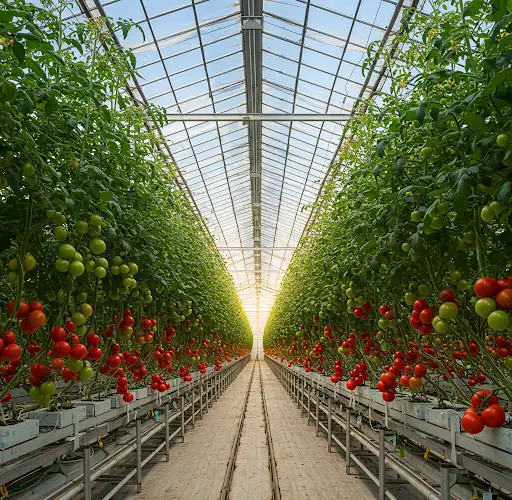The Ultimate Guide to Growing Large, Succulent Tomatoes
Tomatoes are one of the most rewarding crops to grow, but achieving large, juicy, and flavorful fruits requires a bit more than simply planting seeds and hoping for the best. Many gardeners struggle with small or bland tomatoes, unaware that a few simple techniques can make all the difference. If you wish you had discovered these methods earlier, now is the perfect time to implement them. This guide will walk you through essential strategies to maximize the size, taste, and yield of your tomato plants.
1. Choose the Right Variety
Not all tomato varieties are created equal when it comes to size and taste. If your goal is to grow large, succulent tomatoes, opt for beefsteak, Brandywine, Big Boy, or Cherokee Purple varieties. These heirloom and hybrid varieties are known for their impressive size and deep, rich flavors. Cherry or Roma tomatoes are excellent in their own right, but they naturally grow smaller, making them less suitable for those seeking large fruits.
2. Prepare the Soil Properly
Healthy soil is the foundation of thriving tomato plants. Tomatoes require well-draining, nutrient-rich soil with plenty of organic matter. Here’s how to prepare the perfect soil mix:
- Enrich with Compost: Add a generous amount of compost or well-rotted manure to your soil to improve fertility and moisture retention.
- Balance the pH: Tomatoes prefer slightly acidic to neutral soil (pH 6.0-6.8). Test your soil and amend it if needed with lime (to raise pH) or sulfur (to lower pH).
- Boost with Nutrients: Incorporate bone meal for phosphorus (essential for root growth) and greensand or wood ash for potassium (key for flower and fruit development).
3. Start with Strong Seedlings
The quality of your seedlings significantly impacts your harvest. Start your tomato seeds indoors about 6-8 weeks before the last frost. Ensure they receive adequate light (12-16 hours per day) using grow lights or a sunny window. Harden off your seedlings by gradually exposing them to outdoor conditions before transplanting.
4. Plant Deeply for Strong Roots
Tomato plants have the unique ability to grow roots along their stems. Take advantage of this by planting them deeply—burying two-thirds of the stem underground. This encourages a more extensive root system, allowing the plant to absorb more nutrients and water, resulting in larger fruits.
5. Water Wisely
Proper watering is crucial for juicy tomatoes. Here’s how to do it right:
- Deep Watering: Instead of frequent shallow watering, water deeply once or twice a week to encourage deep root growth.
- Consistent Moisture: Inconsistent watering leads to issues like cracking and blossom end rot. Use mulch to retain soil moisture and prevent fluctuations.
- Morning Watering: Water early in the morning to reduce evaporation and minimize fungal diseases.
6. Provide Proper Support
Supporting your tomato plants prevents fruits from touching the ground, reducing the risk of rot and pests. Use sturdy cages, stakes, or a trellis to keep plants upright and promote better air circulation.
7. Prune for Better Growth
Pruning helps direct the plant’s energy toward fruit production rather than excessive foliage. Follow these pruning tips:
- Remove Suckers: These small shoots grow in the crotch between the main stem and branches. Removing them allows the plant to focus on developing larger fruits.
- Trim Lower Leaves: Cut off leaves near the base to prevent soil-borne diseases and improve airflow.
- Limit the Number of Fruit Clusters: Reducing the number of tomatoes per plant can result in larger, more flavorful fruits.
8. Feed Your Plants Properly
Tomatoes are heavy feeders, and regular fertilization is key to high-quality fruits. Use a balanced organic fertilizer or a homemade compost tea rich in nitrogen, phosphorus, and potassium. A good schedule to follow:
- Early Growth Stage: Use a nitrogen-rich fertilizer to promote leafy growth.
- Flowering and Fruiting Stage: Switch to a phosphorus and potassium-heavy fertilizer to enhance blooms and fruit development.
- Regular Feeding: Feed plants every 2-3 weeks to maintain nutrient levels.
9. Encourage Pollination
For optimal fruit development, ensure proper pollination. While tomatoes are self-pollinating, they benefit from additional help:
- Hand Pollination: Gently shake flowers or use a small brush to transfer pollen.
- Attract Pollinators: Plant companion flowers like marigolds, lavender, and basil to invite bees and butterflies.
- Good Airflow: Position plants where they can benefit from natural wind movement to aid in pollination.
10. Prevent Common Tomato Problems
Large, succulent tomatoes are only possible if plants remain healthy. Prevent common issues like:
- Blossom End Rot: Caused by calcium deficiency. Prevent it by maintaining consistent watering and adding crushed eggshells or calcium amendments.
- Fungal Diseases: Avoid wet leaves, space plants properly, and use disease-resistant varieties.
- Pests: Keep an eye out for aphids, hornworms, and whiteflies. Use neem oil, insecticidal soap, or companion planting as natural deterrents.
11. Harvest at the Right Time
Picking tomatoes at the right time ensures the best flavor and texture. Here’s what to look for:
- Color: Fully ripened tomatoes exhibit deep, vibrant hues based on their variety.
- Firmness: A ripe tomato is slightly soft but not mushy.
- Twist & Pull: Harvest by gently twisting the fruit off the vine or using pruning shears.
Conclusion
Growing large, succulent tomatoes isn’t complicated, but it does require attention to detail. By choosing the right variety, preparing nutrient-rich soil, watering correctly, pruning wisely, and preventing diseases, you can enjoy an abundant harvest of delicious tomatoes. Implement these methods today, and you’ll never look at store-bought tomatoes the same way again!



